Yi Lin
Institute of Remote Sensing and Geographic Information System, School of Earth and Space Sciences, Peking University
UrbanFeel: A Comprehensive Benchmark for Temporal and Perceptual Understanding of City Scenes through Human Perspective
Sep 26, 2025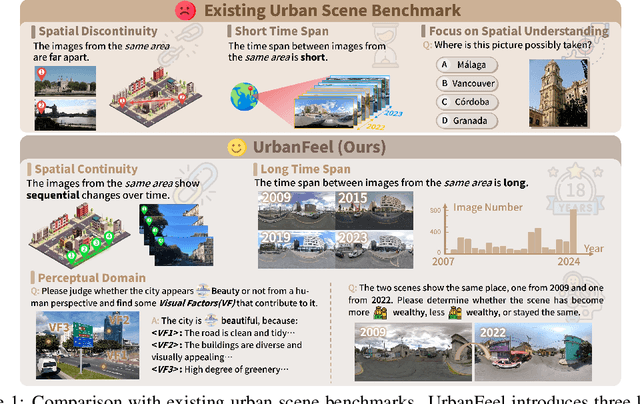
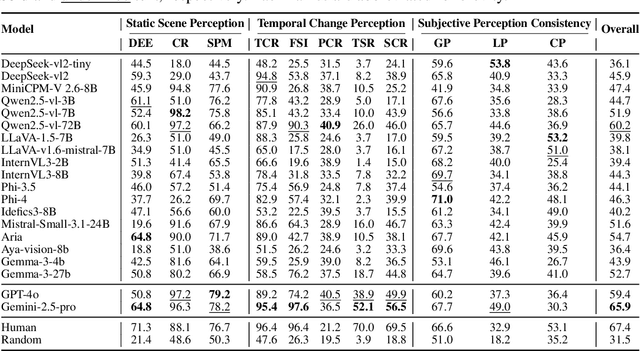
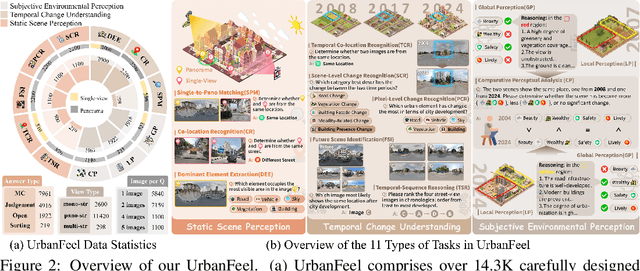
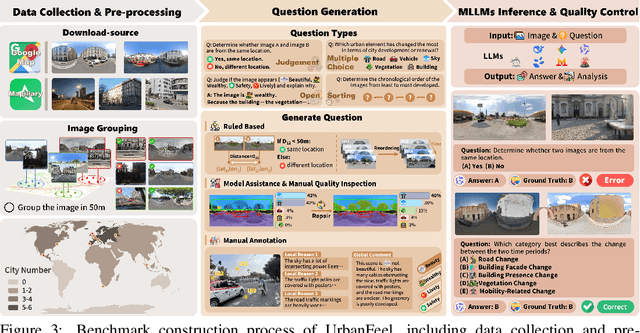
Abstract:Urban development impacts over half of the global population, making human-centered understanding of its structural and perceptual changes essential for sustainable development. While Multimodal Large Language Models (MLLMs) have shown remarkable capabilities across various domains, existing benchmarks that explore their performance in urban environments remain limited, lacking systematic exploration of temporal evolution and subjective perception of urban environment that aligns with human perception. To address these limitations, we propose UrbanFeel, a comprehensive benchmark designed to evaluate the performance of MLLMs in urban development understanding and subjective environmental perception. UrbanFeel comprises 14.3K carefully constructed visual questions spanning three cognitively progressive dimensions: Static Scene Perception, Temporal Change Understanding, and Subjective Environmental Perception. We collect multi-temporal single-view and panoramic street-view images from 11 representative cities worldwide, and generate high-quality question-answer pairs through a hybrid pipeline of spatial clustering, rule-based generation, model-assisted prompting, and manual annotation. Through extensive evaluation of 20 state-of-the-art MLLMs, we observe that Gemini-2.5 Pro achieves the best overall performance, with its accuracy approaching human expert levels and narrowing the average gap to just 1.5\%. Most models perform well on tasks grounded in scene understanding. In particular, some models even surpass human annotators in pixel-level change detection. However, performance drops notably in tasks requiring temporal reasoning over urban development. Additionally, in the subjective perception dimension, several models reach human-level or even higher consistency in evaluating dimension such as beautiful and safety.
(P)rior(D)yna(F)low: A Priori Dynamic Workflow Construction via Multi-Agent Collaboration
Sep 18, 2025Abstract:Recent studies have shown that carefully designed workflows coordinating large language models(LLMs) significantly enhance task-solving capabilities compared to using a single model. While an increasing number of works focus on autonomous workflow construction, most existing approaches rely solely on historical experience, leading to limitations in efficiency and adaptability. We argue that while historical experience is valuable, workflow construction should also flexibly respond to the unique characteristics of each task. To this end, we propose an a priori dynamic framework for automated workflow construction. Our framework first leverages Q-table learning to optimize the decision space, guiding agent decisions and enabling effective use of historical experience. At the same time, agents evaluate the current task progress and make a priori decisions regarding the next executing agent, allowing the system to proactively select the more suitable workflow structure for each given task. Additionally, we incorporate mechanisms such as cold-start initialization, early stopping, and pruning to further improve system efficiency. Experimental evaluations on four benchmark datasets demonstrate the feasibility and effectiveness of our approach. Compared to state-of-the-art baselines, our method achieves an average improvement of 4.05%, while reducing workflow construction and inference costs to only 30.68%-48.31% of those required by existing methods.
From Controlled Scenarios to Real-World: Cross-Domain Degradation Pattern Matching for All-in-One Image Restoration
May 28, 2025Abstract:As a fundamental imaging task, All-in-One Image Restoration (AiOIR) aims to achieve image restoration caused by multiple degradation patterns via a single model with unified parameters. Although existing AiOIR approaches obtain promising performance in closed and controlled scenarios, they still suffered from considerable performance reduction in real-world scenarios since the gap of data distributions between the training samples (source domain) and real-world test samples (target domain) can lead inferior degradation awareness ability. To address this issue, a Unified Domain-Adaptive Image Restoration (UDAIR) framework is proposed to effectively achieve AiOIR by leveraging the learned knowledge from source domain to target domain. To improve the degradation identification, a codebook is designed to learn a group of discrete embeddings to denote the degradation patterns, and the cross-sample contrastive learning mechanism is further proposed to capture shared features from different samples of certain degradation. To bridge the data gap, a domain adaptation strategy is proposed to build the feature projection between the source and target domains by dynamically aligning their codebook embeddings, and a correlation alignment-based test-time adaptation mechanism is designed to fine-tune the alignment discrepancies by tightening the degradation embeddings to the corresponding cluster center in the source domain. Experimental results on 10 open-source datasets demonstrate that UDAIR achieves new state-of-the-art performance for the AiOIR task. Most importantly, the feature cluster validate the degradation identification under unknown conditions, and qualitative comparisons showcase robust generalization to real-world scenarios.
Logo-LLM: Local and Global Modeling with Large Language Models for Time Series Forecasting
May 16, 2025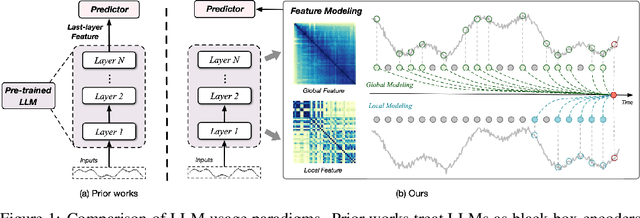
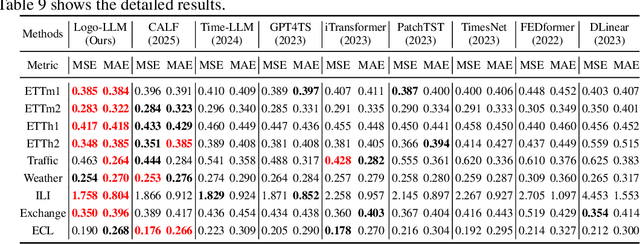
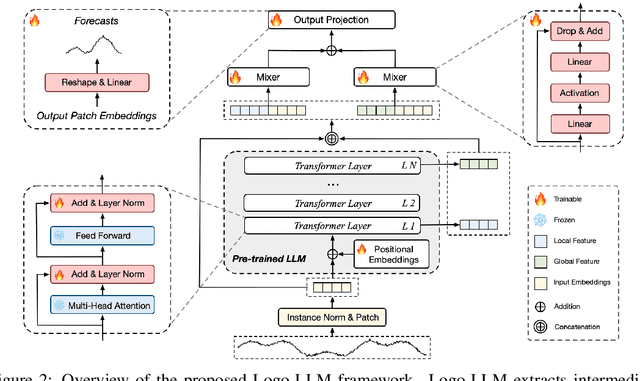

Abstract:Time series forecasting is critical across multiple domains, where time series data exhibits both local patterns and global dependencies. While Transformer-based methods effectively capture global dependencies, they often overlook short-term local variations in time series. Recent methods that adapt large language models (LLMs) into time series forecasting inherit this limitation by treating LLMs as black-box encoders, relying solely on the final-layer output and underutilizing hierarchical representations. To address this limitation, we propose Logo-LLM, a novel LLM-based framework that explicitly extracts and models multi-scale temporal features from different layers of a pre-trained LLM. Through empirical analysis, we show that shallow layers of LLMs capture local dynamics in time series, while deeper layers encode global trends. Moreover, Logo-LLM introduces lightweight Local-Mixer and Global-Mixer modules to align and integrate features with the temporal input across layers. Extensive experiments demonstrate that Logo-LLM achieves superior performance across diverse benchmarks, with strong generalization in few-shot and zero-shot settings while maintaining low computational overhead.
SAS-Bench: A Fine-Grained Benchmark for Evaluating Short Answer Scoring with Large Language Models
May 15, 2025Abstract:Subjective Answer Grading (SAG) plays a crucial role in education, standardized testing, and automated assessment systems, particularly for evaluating short-form responses in Short Answer Scoring (SAS). However, existing approaches often produce coarse-grained scores and lack detailed reasoning. Although large language models (LLMs) have demonstrated potential as zero-shot evaluators, they remain susceptible to bias, inconsistencies with human judgment, and limited transparency in scoring decisions. To overcome these limitations, we introduce SAS-Bench, a benchmark specifically designed for LLM-based SAS tasks. SAS-Bench provides fine-grained, step-wise scoring, expert-annotated error categories, and a diverse range of question types derived from real-world subject-specific exams. This benchmark facilitates detailed evaluation of model reasoning processes and explainability. We also release an open-source dataset containing 1,030 questions and 4,109 student responses, each annotated by domain experts. Furthermore, we conduct comprehensive experiments with various LLMs, identifying major challenges in scoring science-related questions and highlighting the effectiveness of few-shot prompting in improving scoring accuracy. Our work offers valuable insights into the development of more robust, fair, and educationally meaningful LLM-based evaluation systems.
Seed1.5-VL Technical Report
May 11, 2025Abstract:We present Seed1.5-VL, a vision-language foundation model designed to advance general-purpose multimodal understanding and reasoning. Seed1.5-VL is composed with a 532M-parameter vision encoder and a Mixture-of-Experts (MoE) LLM of 20B active parameters. Despite its relatively compact architecture, it delivers strong performance across a wide spectrum of public VLM benchmarks and internal evaluation suites, achieving the state-of-the-art performance on 38 out of 60 public benchmarks. Moreover, in agent-centric tasks such as GUI control and gameplay, Seed1.5-VL outperforms leading multimodal systems, including OpenAI CUA and Claude 3.7. Beyond visual and video understanding, it also demonstrates strong reasoning abilities, making it particularly effective for multimodal reasoning challenges such as visual puzzles. We believe these capabilities will empower broader applications across diverse tasks. In this report, we mainly provide a comprehensive review of our experiences in building Seed1.5-VL across model design, data construction, and training at various stages, hoping that this report can inspire further research. Seed1.5-VL is now accessible at https://www.volcengine.com/ (Volcano Engine Model ID: doubao-1-5-thinking-vision-pro-250428)
Emergence of Painting Ability via Recognition-Driven Evolution
Jan 09, 2025Abstract:From Paleolithic cave paintings to Impressionism, human painting has evolved to depict increasingly complex and detailed scenes, conveying more nuanced messages. This paper attempts to emerge this artistic capability by simulating the evolutionary pressures that enhance visual communication efficiency. Specifically, we present a model with a stroke branch and a palette branch that together simulate human-like painting. The palette branch learns a limited colour palette, while the stroke branch parameterises each stroke using B\'ezier curves to render an image, subsequently evaluated by a high-level recognition module. We quantify the efficiency of visual communication by measuring the recognition accuracy achieved with machine vision. The model then optimises the control points and colour choices for each stroke to maximise recognition accuracy with minimal strokes and colours. Experimental results show that our model achieves superior performance in high-level recognition tasks, delivering artistic expression and aesthetic appeal, especially in abstract sketches. Additionally, our approach shows promise as an efficient bit-level image compression technique, outperforming traditional methods.
Merging Context Clustering with Visual State Space Models for Medical Image Segmentation
Jan 03, 2025



Abstract:Medical image segmentation demands the aggregation of global and local feature representations, posing a challenge for current methodologies in handling both long-range and short-range feature interactions. Recently, vision mamba (ViM) models have emerged as promising solutions for addressing model complexities by excelling in long-range feature iterations with linear complexity. However, existing ViM approaches overlook the importance of preserving short-range local dependencies by directly flattening spatial tokens and are constrained by fixed scanning patterns that limit the capture of dynamic spatial context information. To address these challenges, we introduce a simple yet effective method named context clustering ViM (CCViM), which incorporates a context clustering module within the existing ViM models to segment image tokens into distinct windows for adaptable local clustering. Our method effectively combines long-range and short-range feature interactions, thereby enhancing spatial contextual representations for medical image segmentation tasks. Extensive experimental evaluations on diverse public datasets, i.e., Kumar, CPM17, ISIC17, ISIC18, and Synapse demonstrate the superior performance of our method compared to current state-of-the-art methods. Our code can be found at https://github.com/zymissy/CCViM.
Attentive-based Multi-level Feature Fusion for Voice Disorder Diagnosis
Oct 07, 2024



Abstract:Voice disorders negatively impact the quality of daily life in various ways. However, accurately recognizing the category of pathological features from raw audio remains a considerable challenge due to the limited dataset. A promising method to handle this issue is extracting multi-level pathological information from speech in a comprehensive manner by fusing features in the latent space. In this paper, a novel framework is designed to explore the way of high-quality feature fusion for effective and generalized detection performance. Specifically, the proposed model follows a two-stage training paradigm: (1) ECAPA-TDNN and Wav2vec 2.0 which have shown remarkable effectiveness in various domains are employed to learn the universal pathological information from raw audio; (2) An attentive fusion module is dedicatedly designed to establish the interaction between pathological features projected by EcapTdnn and Wav2vec 2.0 respectively and guide the multi-layer fusion, the entire model is jointly fine-tuned from pre-trained features by the automatic voice pathology detection task. Finally, comprehensive experiments on the FEMH and SVD datasets demonstrate that the proposed framework outperforms the competitive baselines, and achieves the accuracy of 90.51% and 87.68%.
Revisiting Deep Ensemble Uncertainty for Enhanced Medical Anomaly Detection
Sep 26, 2024Abstract:Medical anomaly detection (AD) is crucial in pathological identification and localization. Current methods typically rely on uncertainty estimation in deep ensembles to detect anomalies, assuming that ensemble learners should agree on normal samples while exhibiting disagreement on unseen anomalies in the output space. However, these methods may suffer from inadequate disagreement on anomalies or diminished agreement on normal samples. To tackle these issues, we propose D2UE, a Diversified Dual-space Uncertainty Estimation framework for medical anomaly detection. To effectively balance agreement and disagreement for anomaly detection, we propose Redundancy-Aware Repulsion (RAR), which uses a similarity kernel that remains invariant to both isotropic scaling and orthogonal transformations, explicitly promoting diversity in learners' feature space. Moreover, to accentuate anomalous regions, we develop Dual-Space Uncertainty (DSU), which utilizes the ensemble's uncertainty in input and output spaces. In input space, we first calculate gradients of reconstruction error with respect to input images. The gradients are then integrated with reconstruction outputs to estimate uncertainty for inputs, enabling effective anomaly discrimination even when output space disagreement is minimal. We conduct a comprehensive evaluation of five medical benchmarks with different backbones. Experimental results demonstrate the superiority of our method to state-of-the-art methods and the effectiveness of each component in our framework. Our code is available at https://github.com/Rubiscol/D2UE.
 Add to Chrome
Add to Chrome Add to Firefox
Add to Firefox Add to Edge
Add to Edge